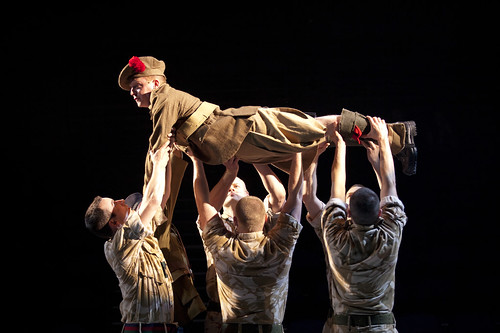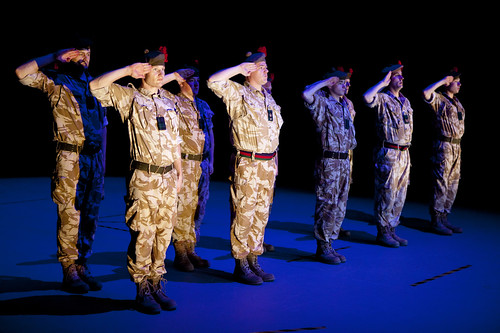Bagpipes, battles and bloody brilliance in Black Watch
One of many dynamic theatrical moments in Black Watch involves a vivid telling of the history of one of Scotland's oldest Highland Regiments. Black Watch, a production of the National Theatre of Scotland and presented locally by American Conservatory Theater, tells the stories of Black Watch soldiers who served tours of duty in Iraq. The multimedia production runs through June 16 in the Drill Court of the Mission Armory. Below: Black Watch involves stories, marches, songs and reenactments of life in Iraq during wartime. Photos by Scott Suchman
It's interesting that the horrors of war – far away from the battlefields – tend to turn into a videogame on the big screen and small screen, with the camera becoming a shield from the action. But somehow, when the theater deploys its magic, you can come closer to feeling what it might be like, moment to moment, if you were really there with the soldiers. In recent memory, two plays have captured attention around the world for exploring the physical and emotional aspect of war, and both are so fully works of live theater you couldn't imagine experiencing them in other form.
The first is War Horse, which uses a giant horse puppet to suspend audience disbelief and put them into World War I trenches in France. The movie of the play isn't anywhere near as powerful as the play because it's so literal. The other is Black Watch, a production of the National Theatre of Scotland, that has been touring for seven years and putting audiences into the headspace and the Iraq front lines held by members of the Black Watch, one of Scotland's oldest Highland Regiments that was sent to bolster the American war effort in Iraq in 2004.
Director John Tiffany, choreographer Steven Hoggett and writer Gregory Burke use the full arsenal of theatrical tricks – dance, song, multimedia, light and sound – to create an experience that is part documentary, part fantasia and fully immersive to convey a sense of what it was really like – and perhaps more importantly, what it really felt like – in that hellish, explosive desert.
Black Watch has been around the world and back (not unlike the actual Black Watch regiment, established in 1745 and sent to fight battles in lands far, far from Scotland), and it finally marched into San Francisco courtesy of American Conservatory Theater, which had the stroke of creative genius to produce the show in the Armory Community Center in the Mission District, an enormous historic building (with a creek running through basement and a porn studio within its vast expanse) with a drill court perfectly suited to military spectacle. With stadium seating on either side of the court – it feels like a more intimate football field, though the bleachers are much more comfortable – the stage feels like it could house a concert or a circus, which, in a way it does both. If Cirque du Soleil were still interesting, it would be staging something as classic and inventive as Black Watch.
There's nothing really new in the two-hour, no-intermission show, but the way Tiffany, Hoggett and Burke combine elements is what keeps it interesting and makes it so emotionally powerful. There are scenes with a writer interviewing the soldiers in pool hall back home. As they recount their time in Iraq, the action shifts to Camp Dogwood in what is known as the "triangle of death." It is also, as one soldier notes, "the ancient land of Babylon, birthplace of civilization." Well there's not much civil about it anymore. The soldiers have barely arrived before the onslaught of mortar and rockets begins. But then there's the boredom of nothing happening. One soldier says a good title for a movie about the Iraq war would be "Sweating Without Moving."
The sound design by Gareth Fry is certainly loud, but it has to be if we're going to get any sense of what it's like to be near actual falling bombs. Designer Colin Grenfell's lights flash, and the sound of explosions rattle the Armory.
But it's not all realism, and that's where Black Watch really takes off. There are surprises that bend reality, but it's always in service of exploring the soldiers' lives, whether it's the external danger and fighting or the internal terror, loneliness, boredom, deep camaraderie or homesickness. One wordless scene involves soldiers reading letters from home. Their responses become gestural, repeated movements that somehow convey everything we need to know. Another standout sequence regales us with the history of the Black Watch, with the storyteller being dressed and undressed in the ever-evolving uniform while being tossed around by his fellow soldiers.
The 10 men in the cast are fully up to the task of Hoggett's rigorous movement, not to mention all the demands of moving things around on Laura Hopkins' efficient set (she does amazing things with a pool table). The march, they climb, they haul, they brawl – and their final dance, sort of a military tattoo that expresses the repeating cycle of service and death and dedication in military life – is breathtaking and leaves you wondering not about the abilities or the extraordinary work of the soldiers but about the leaders who put that good work to such dubious use.
Cammy (Stuart Martin), who is sort of the de facto narrator and emotional center of the story, repeatedly says that these highly trained soldiers aren't really able to utilize that training in Iraq. The rules are different there. They are mortared mercilessly, yet they can't fire back. And there's absolutely no way to deal with suicide bombers. All this, Cammy says, "And for what?" A sergeant calls Iraq, "the biggest Western foreign policy disaster ever." Watching the futility of the warfare on display here it's hard to disagree.
These soldiers are not painted as generic heroes but as complicated men/boys who are proud of their service and prone to foul language and childish games like "toby tag" (with toby being a penis and the tagging being a slap on another soldier's face). But you come to feel for them and want them to succeed. The sheer energy and vitality and likability of the cast goes a long way toward making the grueling experience of war a captivating, emotionally powerful theatrical experience.
[bonus interview]
I talked to Black Watch director John Tiffany for a story in the San Francisco Chronicle. Read the interview here (may require subscription).
FOR MORE INFORMATION
Black Watch, presented by the National Theatre of Scotland and American Conservatory Theater, continues through June 16 at the Drill Court in the Armory Community Center, 333 14th St., San Francisco. Tickets are $100. Call 415-749-2228 or visit www.act-sf.org
.

